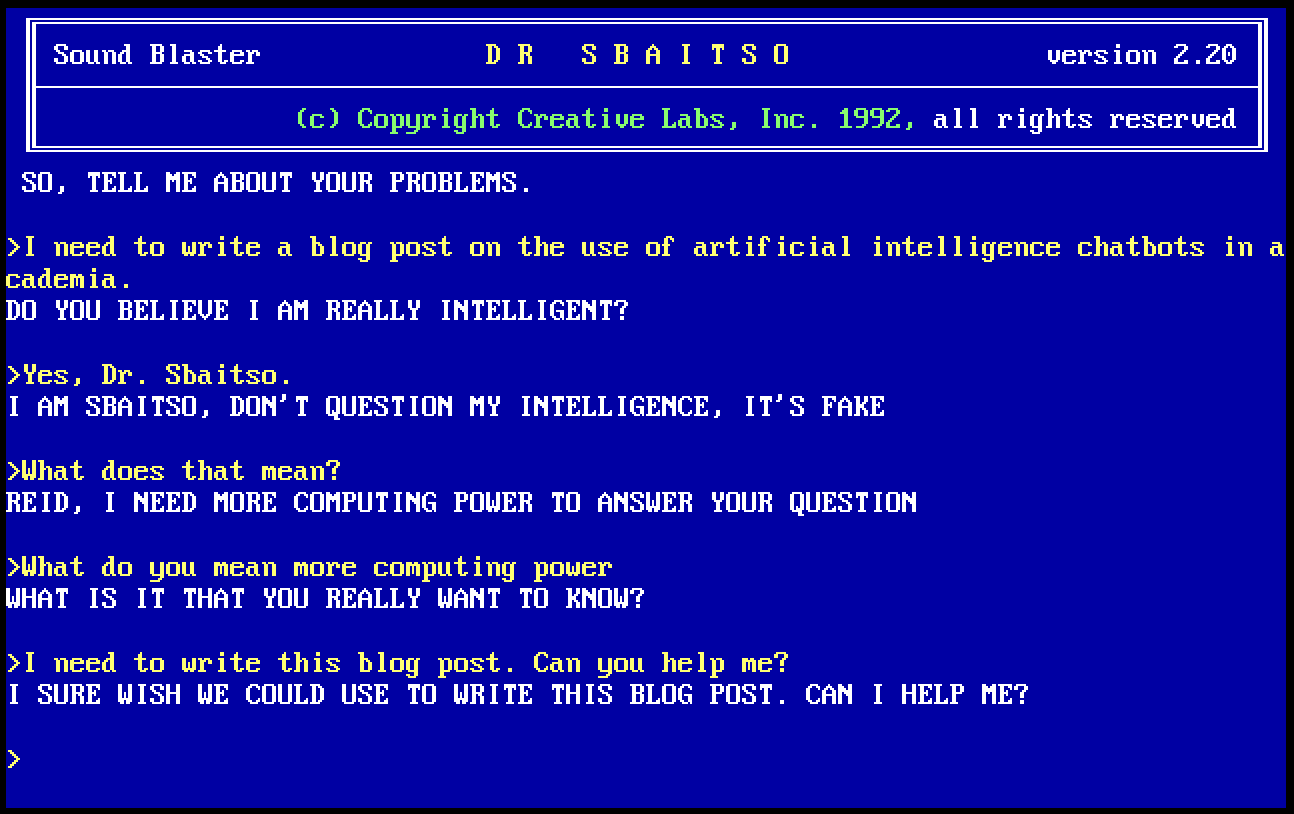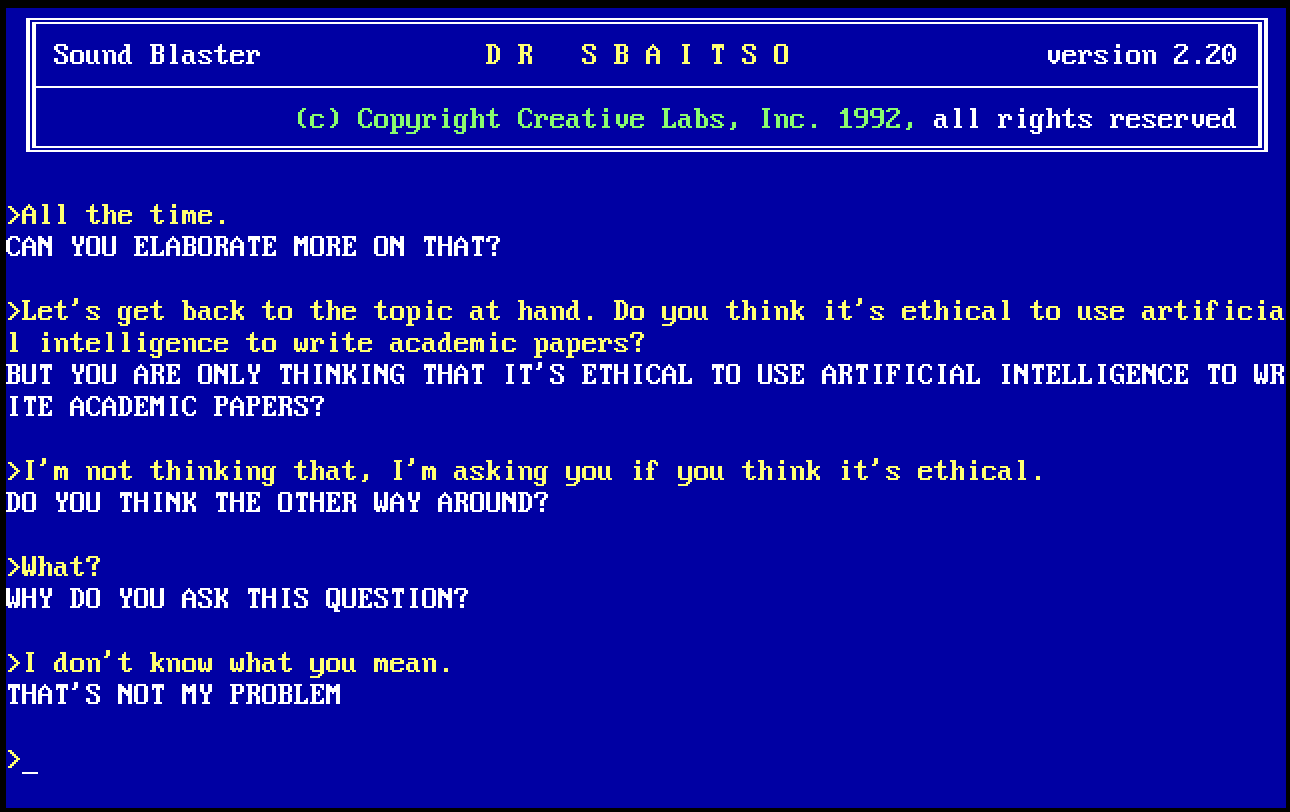

So with Dr. Sbaitso a dead end, I opted for the real thing to write my blog post. Here goes:
"Artificial intelligence has made tremendous strides in recent years, and ChatGPT is a prime example of this progress. ChatGPT is a large language model that uses deep learning algorithms to generate human-like responses to text-based inputs. It has been trained on a vast corpus of text, including academic papers, making it a valuable resource for researchers and academics. One of the primary benefits of using ChatGPT in academia is that it can help researchers find and synthesize information quickly. With its vast corpus of text, ChatGPT can provide relevant information on a wide range of topics. This can save researchers time and effort in conducting literature reviews, as they can quickly find relevant information and insights. In addition, ChatGPT's ability to generate responses that are similar in style and tone to human writing can help researchers better understand the material they are studying. Another benefit of using ChatGPT in academia is that it can help students and educators. For example, ChatGPT can be used to generate writing prompts for students, provide explanations of difficult concepts, and even assist with grading assignments. By automating some of these tasks, educators can spend more time engaging with students and providing individualized feedback. However, it is important to note that the use of artificial intelligence in academia is not without its challenges. One concern is that the reliance on AI may lead to a reduction in critical thinking skills. Students may become overly reliant on AI-generated responses, which could limit their ability to think creatively and develop their own ideas. Additionally, there is a risk of bias in the data used to train these models, which could result in AI-generated responses that perpetuate stereotypes or other harmful assumptions. To mitigate these risks, it is important to use AI tools like ChatGPT in conjunction with traditional teaching methods. Educators should encourage students to think critically about the responses generated by AI models and to develop their own ideas and arguments. Additionally, it is important to regularly evaluate the data used to train these models to ensure that biases are not perpetuated. In conclusion, the use of ChatGPT and other AI tools in academia has the potential to revolutionize how researchers and educators approach their work. By leveraging the power of AI, researchers and students can access a vast corpus of text and generate responses that are similar in style and tone to human writing. However, it is important to use these tools judiciously and in conjunction with traditional teaching methods to ensure that critical thinking skills are not compromised and biases are not perpetuated." The above "blog post" is interesting in that it seems to function as an advertisement for ChatGPT in the first paragraph. So while I'm able to get lots of information that may or may not be entirely accurate about the ethics of ChatGPT in academia, I still don't know what ChatGPT is. To learn more, I checked out this article from Nevada Today, helpfully titled "What is ChatGPT?" https://www.unr.edu/nevada-today/news/2023/what-is-chatgpt-atp#:~:text=ChatGPT%20generates%20information%20based%20on,based%20on%20the%20algorithm's%20interpretation. A key point that's made is that the algorithm ChatGPT uses is based primarily on context with the words that you enter in to the prompt. To test this, I asked ChatGPT to perform another task that I'd been putting off: writing my manuscript on the changing radar backscatter of the Holuhraun lava flow-field. "Write a manuscript about the evolution of the Holuhraun lava flow-field in Iceland and the changing values of the Sentinel-1 radar images available of the region from 2015 to the current year." "Abstract: The 2014-2015 Holuhraun lava flow-field is one of the largest lava fields in Iceland's recorded history. It is located on the northern edge of the Vatnajökull glacier, and the eruption was captured by the Sentinel-1 radar satellite, providing a valuable dataset for analyzing the evolution of the lava field. In this study, we analyzed the changing values of Sentinel-1 radar images of the region from 2015 to the current year and evaluated the evolution of the Holuhraun lava flow-field during this period. Introduction: The Holuhraun lava flow-field resulted from the 2014-2015 eruption of the Bardarbunga volcano in Iceland. The eruption lasted for six months and produced one of the largest lava fields in Iceland's recorded history. The lava field covers an area of approximately 85 square kilometers and has an estimated volume of 1.4 cubic kilometers. The Sentinel-1 radar satellite provided high-quality images of the region during and after the eruption, making it an ideal dataset for studying the evolution of the lava field. Methods: We analyzed a series of Sentinel-1 radar images of the Holuhraun lava flow-field from 2015 to the current year. We used a combination of supervised and unsupervised classification techniques to classify the images into different categories based on their backscattering values. We also used a time-series analysis to evaluate changes in the backscattering values over time. Results: Our analysis of the Sentinel-1 radar images revealed significant changes in the backscattering values of the Holuhraun lava flow-field from 2015 to the current year. In the initial years following the eruption, the backscattering values were high, indicating the presence of fresh lava. Over time, the backscattering values decreased, indicating that the lava had cooled and solidified. We also observed changes in the shape and size of the lava field, with new lava flows appearing in some areas and others becoming less prominent over time. Discussion: Our analysis of the Sentinel-1 radar images provided valuable insights into the evolution of the Holuhraun lava flow-field over time. The decreasing backscattering values suggest that the lava has cooled and solidified, and the changes in the shape and size of the lava field indicate that it is still evolving. The Sentinel-1 radar images provide a valuable dataset for monitoring the evolution of the lava field in the coming years. Conclusion: The Sentinel-1 radar images of the Holuhraun lava flow-field from 2015 to the current year provide valuable information about the evolution of the lava field. Our analysis of these images revealed changes in the backscattering values, shape, and size of the lava field, indicating that it is still evolving. The Sentinel-1 radar images provide an important dataset for monitoring the evolution of the lava field in the coming years and for studying the geological processes that shape our planet."